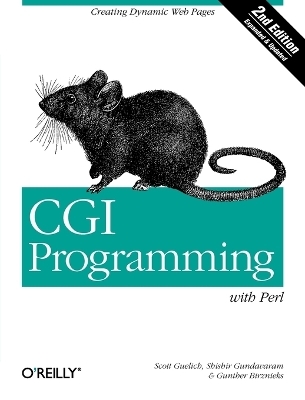CGI Programming with Perl 2e
O'Reilly Media (Verlag)
978-1-56592-419-2 (ISBN)
Programming on the Web today can involve any of several technologies, but the Common Gateway Interface (CGI) has held its ground as the most mature method--and one of the most powerful ones--of providing dynamic web content. CGI is a generic interface for calling external programs to crunch numbers, query databases, generate customized graphics, or perform any other server-side task. There was a time when CGI was the only game in town for server-side programming; today, although we have ASP, PHP, Java servlets, and ColdFusion (among others), CGI continues to be the most ubiquitous server-side technology on the Web. CGI programs can be written in any programming language, but Perl is by far the most popular language for CGI. Initially developed over a decade ago for text processing, Perl has evolved into a powerful object-oriented language, while retaining its simplicity of use. CGI programmers appreciate Perl's text manipulation features and its CGI.pm module, which gives a well-integrated object-oriented interface to practically all CGI-related tasks. While other languages might be more elegant or more efficient, Perl is still considered the primary language for CGI.
CGI Programming with Perl, Second Edition, offers a comprehensive explanation of using CGI to serve dynamic web content. Based on the best-selling CGI Programming on the World Wide Web, this edition has been completely rewritten to demonstrate current techniques available with the CGI.pm module and the latest versions of Perl. The book starts at the beginning, by explaining how CGI works, and then moves swiftly into the subtle details of developing CGI programs. Topics include: * Incorporating JavaScript for form validation * Controlling browser caching * Making CGI scripts secure in Perl * Working with databases * Creating simple search engines * Maintaining state between multiple sessions * Generating graphics dynamically * Improving performance of your CGI scripts
Scott Guelich graduated from Oberlin College in 1993 with a philosophy degree and decided to "only take a few years off" before continuing with graduate school. Unable to find any listing for "Philosopher Wanted" in the classifieds, and having done some programming while growing up, he quickly found himself working with computers. He discovered the Internet the following year and Perl the year after that. Scott has been a web developer for the past few years and currently contracts in the San Francisco Bay Area. He enjoys taijiquan, mountain biking, wind surfing, skiing, and anything that gets him outside and closer to nature. Despite the hours he spends working online, Scott is actually a closet Luddite who doesn't own a television, hasn't bought a cell phone, and still intends to make it to graduate school . . .some day. Gunther Birznieks currently works for Barclays Capital in London, one of the leading global investment banks in Europe, and has previously worked as a computer scientist in the Human Genome Project. Gunther is also known for co-creating Extropia with Selena Sol. Extropia is one of the best known public domain web programming archives. In addition, he has given talks and written books on a variety of subjects related to web programming (Perl, CGI, JavaTM). Shishir Gundavaram is the Director of Technology for MechanicNet.com, a company that provides tools and services for the automotive aftermarket. When he is not dealing with mechanics and broken down cars, Shishir also covers as the CEO of lifeguru.com, the comprehensive health and wellness portal for WAP compatible wireless devices. In his free time, Shishir enjoys sprinting, and still harbors hopes of competing in a meaningful race, before he "retires" from the sport.
Preface 1. Getting Started History Introduction to CGI Alternative Technologies Web Server Configuration 2. The Hypertext Transport Protocol URLs HTTP Browser Requests Server Responses Proxies Content Negotiation Summary 3. The Common Gateway Interface The CGI Environment Environment Variables CGI Output Examples 4. Forms and CGI Sending Data to the Server Form Tags Decoding Form Input 5. CGI.pm Overview Handling Input with CGI.pm Generating Output with CGI.pm Alternatives for Generating Output Handling Errors 6. HTML Templates Reasons for Using Templates Server Side Includes HTML::Template Embperl Mason 7. JavaScript Background Forms Data Exchange Bookmarklets 8. Security The Importance of Web Security Handling User Input Encryption Perl's Taint Mode Data Storage Summary 9. Sending Email Security Email Addresses Structure of Internet Email sendmail mailx and mail Perl Mailers procmail 10. Data Persistence Text Files DBM Files Introduction to SQL DBI 11. Maintaining State Query Strings and Extra Path Information Hidden Fields Client-Side Cookies 12. Searching the Web Server Searching One by One Searching One by One, Take Two Inverted Index Search 13. Creating Graphics on the Fly File Formats Outputting Image Data Generating PNGs with GD Additional GD Modules PerlMagick 14. Middleware and XML Communicating with Other Servers An Introduction to XML Document Type Definition Writing an XML Parser CGI Gateway to XML Middleware 15. Debugging CGI Applications Common Errors Perl Coding Techniques Debugging Tools 16. Guidelines for Better CGI Applications Architectural Guidelines Coding Guidelines 17. Efficiency and Optimization Basic Perl Tips, Top Ten FastCGI mod_perl A. Works Cited and Further Reading B. Perl Modules Index
| Erscheint lt. Verlag | 8.8.2000 |
|---|---|
| Reihe/Serie | OREILLY |
| Verlagsort | Sebastopol |
| Sprache | englisch |
| Einbandart | kartoniert |
| Themenwelt | Mathematik / Informatik ► Informatik ► Programmiersprachen / -werkzeuge |
| Mathematik / Informatik ► Informatik ► Web / Internet | |
| ISBN-10 | 1-56592-419-3 / 1565924193 |
| ISBN-13 | 978-1-56592-419-2 / 9781565924192 |
| Zustand | Neuware |
| Haben Sie eine Frage zum Produkt? |
aus dem Bereich




